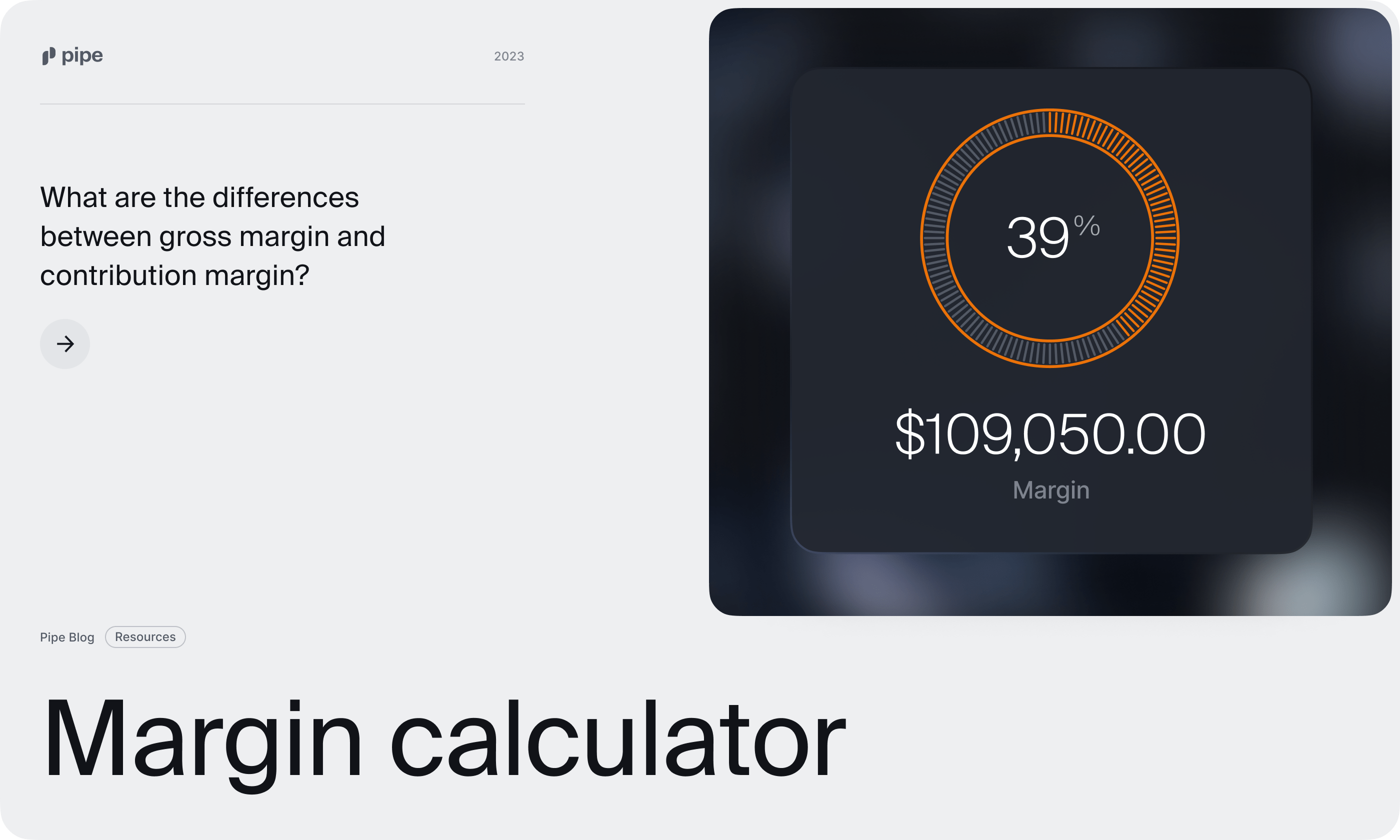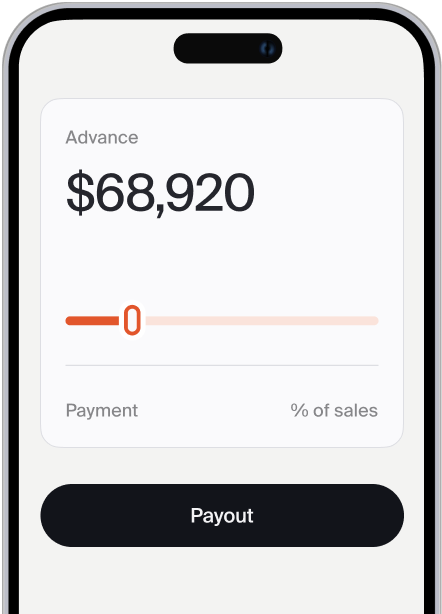How optimizing inventory management can improve your cash flow
While profit can be a great way to measure the success of your business, cash flow is essential to keeping your business running.
By Pipe 7 Min Read — July 7, 2023

While profit can be a great way to measure the success of your business, cash flow is essential to keeping your business running. And if you’re a product-based business, your inventory is one of the biggest factors for managing cash flow. It’s easy to tie up a lot of cash in inventory, and optimizing your inventory management process lets you keep enough free cash available for other operational expenses.
Having the right strategy to manage inventory will push your cash flow in a positive direction. It’ll help you keep the right products in stock, avoid excess inventory, predict cash flow, and understand the best time to order new inventory.
So, how do inventory and cash flow work together? Keep reading to find out.
Why cash flow is so important for businesses
Cash flow is the money that flows in and out of your business, reflected on your cash flow statement. Cash flows in from product sales, investment income, and asset sales—while it flows out through inventory purchases, interest payments, rent, and salaries.
Good cash flow means you can pay your bills and keep investing in growth. When you have money coming in and good cash flow projections, you can invest in product research, test product categories, research new designs, and build marketing campaigns.
Poor cash flow will impact your ability to operate and grow. Even if you have good profit margins, if you can’t reliably collect money from customers and other sources, you don’t have a predictable source of cash to cover expenses or re-invest. One late invoice payment means you may struggle to pay expenses and be unable to buy the inventory to sell to customers.
How does inventory affect cash flow
Inventory is one of your greatest assets as a product business. You need enough stock to fulfill orders, and if you run out, you run the risk of missing sales and losing customers—or at least losing out on customer satisfaction.
The problem comes when you don’t accurately predict how much inventory you need. Buying too little inventory saves money but increases the risk of out-of-stocks. If you purchase too much inventory, your company may tie up cash in products that sit on the shelf and may even need to be discounted to sell before they expire or go out of style.
Inventory optimization will help you maximize your company’s cash flow. You can use current demand forecasting and historical data to determine how much you can expect to sell monthly. This information will give you insight into the optimal inventory to buy to avoid running out or keeping too much in stock, giving you an ideal inventory level.
Inventory management tips for improving cash flow
So, now you know why inventory management matters for cash flow. What are a few ways to optimize inventory for better cash flow? Let’s take a look.
Track order volume
One of the first steps to smart inventory management is understanding how much product you’re currently selling. Use your inventory management software to create a report covering how much of each product SKU you’ve sold.
You can use different timeframes to gather further insights—daily and monthly reports can help you see how effective your current advertising tactics are. Yearly reports will help you see trends over time and historical order volume during different points in the year.
Your goal is to determine how much inventory you sell each month. This number will help you determine how much inventory you need to order from suppliers and how frequently you need to order.
Track this data regularly and keep an eye on the reports to see trends and make smart decisions based on those changes. This will keep you from overstocking and understocking items that have changed in popularity.
Classify popular products
As time passes, you’ll probably see a few of your products do better than the rest. These best sellers will generate the bulk of your company’s revenue. These are the products you’ll need to keep the most of in stock. They’re not only the SKUs you’ll sell most from day to day and the biggest risk for out-of-stocks, they’re also the least likely to cause overstocking problems, as you can sell through any excess quickly. If the 80/20 principle holds true (and it usually does), you’ll see 80% of your sales from about 20% of your products.
But that doesn’t stop some companies from stocking many products that underperform. Instead of varying their inventory stock levels for products that don’t sell well, companies still purchase too much, hoping an unpopular product will have future demand and sell more. Companies also consider bulk discounts and believe that saving money on inventory means their business is better off overall. But this isn’t always the case.
While stocking up in bulk may give you a wider gross profit margin, it can cause more problems than it’s worth. More inventory can result in dead stock and excess products, which tie up your cash. You can’t pay the bills with extra widgets, so you often end up discounting them to bring in much-needed cash. Those products that don’t sell well will sit in your warehouse, wasting space, which also costs you money because you’re paying for more warehouse space than your business actually needs.
Instead, focus on keeping inventory levels up for your best products and reduce the space used for storing inventory items that don’t sell well. Doing this will free up cash flow to experiment with other products or invest in other profitable business activities to fuel growth. (If you sell a ton of shoes but only a few pairs of socks, don’t tie up your cash by buying too many socks. That way, when black socks go out of style and red socks are the new trend (or your supplier gives you a great deal on shoes), you’ll have the cash to order what you need and won’t be stuck with inventory you can’t move. When Thing 2 becomes the newest trend, you don’t want to be stuck with 1000 units of Thing 1 and no cash to stock up on Thing 2.)
How to calculate inventory turnover ratio
While there are many granular ways to look at inventory, SKU-by-SKU, one great way to get an overall look at your inventory management is to calculate your inventory turnover ratio. Essentially, this ratio tells you how often you turn over your total inventory, on average, during a certain period. For example, if you measure the inventory turnover ratio for the full year, the ratio will show how many times you’ll sell through the entire stock in a year. A low number may indicate slow sales, but often indicates excessive inventory (i.e., stocking enough to last you months when you can easily restock more often). A high ratio, then, can indicate strong sales or possibly too little inventory on hand, if quick turnover leads to out-of-stocks.
Inventory turnover ratio formula
To calculate the inventory ratio, divide your COGS by your average inventory value.
Inventory Turnover = COGS / Average Inventory Value
This formula makes use of COGS for comparison, because inventory is recorded at cost in your accounting system. These are the costs directly attributed to manufacturing or acquiring the goods. Average inventory is calculated by simply adding your beginning and ending inventory for the period and dividing by two.
Aim for just-in-time ordering
When optimizing inventory management, your ultimate goal is to minimize the amount of cash you have tied up in inventory. You want your inventory to sell quickly, giving you the cash required to buy the next batch of inventory for future customers.
This means reducing your order size as much as possible. You only want enough stock to satisfy your current customer demands without running out of stock before your next order.
Remember that this process can take time to get up and running, including dialing in:
Reliable vendors: Late with shipments can result in items being out of stock, so you need dependable suppliers to meet deadlines and quickly accept new orders.
Accurate forecasting: You need accurate forecasting based on past order data and current market trends to estimate how much supply you need in the future—without it you can’t order the correct inventory to meet ongoing demand.
Accurate inventory records: A reliable inventory management system, including physical audits to confirm data, is the foundation of your forecasting and tracking. Whether you use retail inventory management software or ERP inventory management tools built into your system, make sure everything is kept current and accurate.
Don’t be afraid to liquidate poor-performing products
As a business owner, you won’t always get it right when it comes to ordering or predicting trends. A new product may not sell as well as you expected, but that doesn’t mean the unsold inventory should keep haunting you for months to come. Liquidating old products will help you free up inventory space and generate cash flow for better-performing inventory.
Improve supplier relationships
Your relationship with your supplier may be one of the most essential factors in helping you optimize your inventory management. When you start working with a supplier, there may be little trust. A supplier doesn’t know if you’re a good customer yet, so you may not get the best terms.
But as time passes and trust builds, you can start working to change those terms. One example of this is supplier lead times. Receiving your ordered products quicker will allow you to stock fewer products and have more confidence in maintaining a just-in-time inventory control system.
Net terms are another thing to negotiate with trusted vendors. Again, you’ll get standard terms to begin with, but you can ask to improve them as you build trust with the vendor. For instance, if you’re purchasing inventory on net 30 terms, and your supplier lets you increase to net 45, those additional 15 days can make a huge difference.
Better terms are a big plus if you have a fast-selling product. You can quickly sell your inventory and pay some or all of your inventory and shipping costs without sacrificing cash flow. As your cash flow improves, you may also be able to get discounted terms by paying faster. For instance, 2% 10 net 30 terms would give you 30 days to pay or a 2% discount if paid within 10. This is one way better inventory management and improved cash flow can also grow your profit margins.
Consider financing your inventory
Many of the tips above have focused on avoiding excessive inventory. While tying up your cash in too much inventory is a huge problem, many businesses also struggle to have enough inventory to meet demand. Inventory financing can be the solution to accessing cash flow when you need it so you can order on time.
There are many financing options available for product companies, like:
Bank loans
Outside investors
Revenue advance capital
Improving your inventory turnover by keeping lower stock levels—especially on slow movers—and ordering just in time, you can give your cash flow a huge boost. By partnering with a working capital provider, you can accelerate that cash flow to keep you running smoothly through all the ups and downs of a product-based business.
Having a financing partner in place, so you can access working capital quickly, on an ongoing basis, makes it simple to tap into cash flow when you need it.
Disclaimer: Pipe and its affiliates don't provide financial, tax, legal, or accounting advice. What you're reading has been prepared for knowledge-sharing and informational purposes only. Please consult your financial and legal advisors to determine what transactions and decisions are right for you and your business.
Share this article

June 26, 2023 — 13min read
Gross Margin vs contribution margin (with free simple calculators)
13min —June 26, 2023

June 13, 2023 — 2min read
A new era of fintech collaboration: Pipe joins the Financial Technology Association
2min —June 13, 2023

June 12, 2023 — 6min read
What’s the difference between cash flow and profit, and why does it matter to your business?
6min —June 12, 2023


